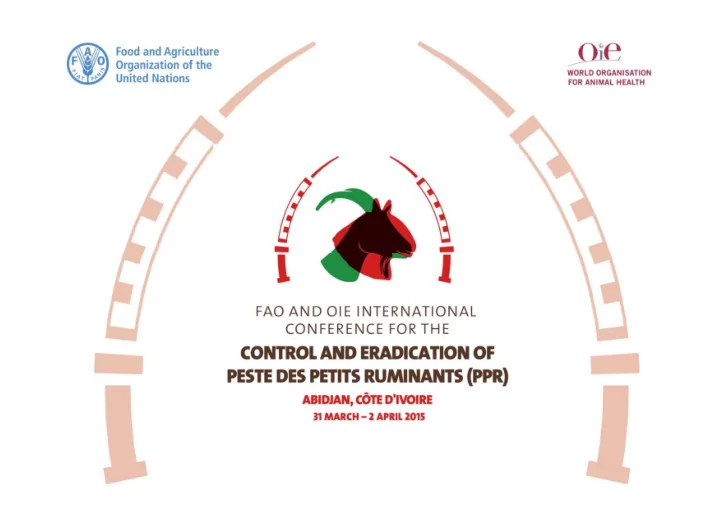

Susanne Münstermann Felix Njeumi OIE Paris, FAO Rome Post vaccination evaluation tool
Introduction • Vaccination is key to PPR control • Vaccination is the main tool in Stage 2 and 3 of the GCES • Performance of the vaccination campaign has to be evaluated; a set of tools is available for this evaluation: A. Serology B. Surveillance in vaccinated herds C. Sociological surveys D. Productivity surveys • A combination of methods Is recommended 3
General considerations • Vaccination campaign is a composite of different factors: Quality of vaccine Vaccination delivery & storage Vaccination coverage Vaccination campaign planning Vaccination protocol • Certain CCPs can be identified along this chain • There is need for close collaboration with the national laboratories – quick turn around time • Harmonisation of sampling protocols at national / regional level for interpretation of results 4
A. Serology Questions that serology can try to answer: • The baseline level of epi-units that have been exposed to PPRV prior to vaccination • Estimate the number of epi-units that demonstrate sero- conversion after vaccination, i.e. that are protected • Increase in the number of epi-units over time that are protected by comparison with the baseline survey • Analysis of age strata that are protected 5
1. Objectives for PVE using Serology • Immune response to vaccination • Population immunity at a given point in time • Trend of population immunity over a series of vaccination campaigns 6
2. Assumptions • Continuous production of susceptible animals at flock level Animals under 3 mths are protected • Threshold for successful vaccination: 70% of animals within epi unit is protected • Study population large – max no of samples • Animals are not individually identified • Shoats are sampled 7
3. Definitons • Target population: susceptible shoats • Study population: shoats to be vaccinated stratified by age 3 different husbandry systems (same as in surveillance protocol) 8
Definitions cont. • Epidemiological unit: Same chance of being infected and of being vaccinated Village or flock • Case definition: When 30% or more in the epi unit are found negative in the serological test - susceptible 9
4. Sampling frame Sample size to detect 30% sero-negative with 95% CI Multi-stage sampling: 1. epi units allocated proportionally to husbandry systems 2. households/flocks selected within epi units by systematic random sampling 3. Animals selected in households/flocks using simple random sampling 10
5. Protocols for different PVE objectives Note: details of sampling strategy are described in the Annex to the GCES 11
6. Interpretation of results Taking the SE and SP of the sampling strategy into consideration: • No of animals/epi unit < 27 : 0 – 1 animal sero- negative • No of animals/epi unit > 27: 0 – 2 animals sero- negative = epi unit is protected • The results can be differentiated per age group to provide with more specific information on unprotected/protected age strata 12
B. Surveillance • Surveillance methods to be used at any of the GCES stages • Sero – surveillance only in unvaccinated parts of the national herd • PVE serology in vaccinated parts of the national herd • Participatory disease search (PDS) Semi-qualitative, use of semi-structured questionnaires Objective: assess together with the farmers the disease incidence at the start of the control effort and during implementation of control 13
C. Sociological surveys Aim: identify the main drivers impacting on vaccine campaign efficacy Method: link the information of the 2 partners (the livestock keeper and the vaccinator) and carry out participatory diagnosis Important ingredients: • Communication networks and messages that were used to announce the vaccination campaign • Use of semi-structured questionnaires • Social network analysis 14
D. Productivity survey Aim: by measuring the (positive) impact of vaccination on herd productivity, assess the vaccination effectiveness Method: 12MO method is published, valid for small or medium-sized herds Ingredients: • Species • Agro-ecological zones and husbandry systems • PPR status of herd (free or infected) • Training of enumerators 15
Final considerations • A “toolbox” with a set of tools is described to evaluate the effectiveness and the impact of vaccination campaigns • For all tools harmonisation of protocols at national but also at regional level is important in order to analyse and compare results and progression in the control of the disease • For all tools it is important to reinforce the national, regional and international networks of epidemiolgists, laboratories and sociologists • Training of people carrying out PVE is imperative • A dedicated budget needs to be allocated to PVE 16
Final considerations • If the results of the methods or a combination thereof indicate that vaccination was not successful, investigations into the sources need to be made => check each of the CCPs and introduce corrective action => Monitoring system of the vaccination programme • Importance of regional / international coordination of these M&E systems in view of harmonised interpretation of results 17
Conclusion • GCES has a toolbox to evaluate the effectiveness of vaccination campaigns – the key tool in stage 2 and 3 • Each tool is described with sufficient level of detail to be practical and feasible in its application 18
Thank you for your attention s.munstermann@oie.int; felix.njeumi@fao.org Acknowledgements Joseph Domenech, OIE Gregorio Torres, OIE Renaud Lancelot, CIRAD Marisa Peyre, Fanny Bouyer, CIRAD
Recommend
More recommend